| The neutrality of this article is disputed. Relevant discussion may be found on the talk page. Please do not remove this message until conditions to do so are met. (July 2024) (Learn how and when to remove this message) |





The Barbary corsairs, Barbary pirates, Ottoman corsairs, or naval mujahideen (in Muslim sources) were mainly Muslim corsairs and privateers who operated from the largely independent Barbary states. This area was known in Europe as the Barbary Coast, in reference to the Berbers. Slaves in Barbary could be of many ethnicities, and of many different religions, such as Christian, Jewish, or Muslim. Their predation extended throughout the Mediterranean, south along West Africa's Atlantic seaboard and into the North Atlantic as far north as Iceland, but they primarily operated in the western Mediterranean. In addition to seizing merchant ships, they engaged in razzias, raids on European coastal towns and villages, mainly in Italy, France, Spain, and Portugal, but also in the British Isles, and Iceland.
While such raids began after the Muslim conquest of the Iberian Peninsula in the 710s, the terms "Barbary pirates" and "Barbary corsairs" are normally applied to the raiders active from the 16th century onwards, when the frequency and range of the slavers' attacks increased. In that period, Algiers, Tunis and Tripoli came under the sovereignty of the Ottoman Empire, either as directly administered provinces or as autonomous dependencies known as the Barbary states. Similar raids were undertaken from Salé (see Salé Rovers) and other ports in Morocco.
Barbary corsairs captured thousands of merchant ships and repeatedly raided coastal towns in Europe. As a result, residents abandoned their former villages on long stretches of coast in Spain and Italy.
The raids were such a problem that coastal settlements were seldom undertaken until the 19th century. Between 1580 and 1680, corsairs were said to have captured about 850,000 people as slaves and from 1530 to 1780 as many as 1.25 million people were enslaved. However, these numbers are estimated and provided by only one historian, Robert Davis, and have been questioned by others like David Earle. Some of these corsairs were European outcasts and converts (renegade) such as John Ward and Zymen Danseker. Hayreddin Barbarossa and Oruç Reis, the Turkish Barbarossa brothers, who took control of Algiers on behalf of the Ottomans in the early 16th century, were also notorious corsairs. The European pirates brought advanced sailing and shipbuilding techniques to the Barbary Coast around 1600, which enabled the corsairs to extend their activities into the Atlantic Ocean. The effects of the Barbary raids peaked in the early-to-mid-17th century.
Long after Europeans had abandoned oar-driven vessels in favor of sailing ships carrying tons of powerful cannon, many Barbary warships were galleys carrying a hundred or more fighting men armed with cutlasses and small arms. The Barbary navies were not battle fleets. When they sighted a European frigate, they fled.
The scope of corsair activity began to diminish in the latter part of the 17th century, as the more powerful European navies started to compel the Barbary states to make peace and cease attacking their shipping. However, the ships and coasts of Christian states without such effective protection continued to suffer until the early 19th century. Between 1801 and 1815, occasional incidents occurred, including two Barbary Wars waged by the United States, Sweden and the Kingdom of Sicily against the Barbary states. Following the Napoleonic Wars and the Congress of Vienna in 1814–15, European powers agreed upon the need to suppress the Barbary corsairs entirely. The remainder of the threat was finally subdued for Europeans by the French conquest of Algeria in 1830 and so-called "pacification" by the French during the mid-to-late 19th century.
History
The Barbary corsairs were active from medieval times to the 1800s.
Muslim Historical Narratives
Both Europeans (e.g., the Dum Diversas) and Muslims considered themselves to be waging holy wars against each other during this era. European and American historical sources bluntly consider these operations to be a form of piracy and that their goal was mainly to seize ships to obtain spoils, money, and slaves. Muslim sources, however, sometimes refer to the "Islamic naval jihad"—casting the conflicts as part of a sacred mission of war under Allah, differing from the more familiar form of jihad only in being waged at sea. Accounts of Andalusian Muslims being persecuted by the notoriously ruthless Spanish Inquisition—willingly abetted by the so-called "Catholic Monarchs", who (though inaugurating what would later become Spain's "Golden Age") were initially faced with the post-Reconquista necessity of binding their (hitherto-divided) territories together, and hence adopted a militantly Christian national identity—provided more than enough justification, in Muslim eyes.

The Middle Ages
In 1198, the problem of Barbary piracy and slave-taking was so significant that the Trinitarians, a religious order, was founded to collect ransoms and even to exchange themselves as a ransom for those captured and pressed into slavery in North Africa. In the 14th century, Tunisian corsairs became enough of a threat to provoke a Franco-Genoese attack on Mahdia in 1390 (also known as the "Barbary Crusade"). Moorish exiles of the Reconquista and Maghreb pirates added to the numbers, but it was not until the expansion of the Ottoman Empire and the arrival of the privateer and admiral Kemal Reis in 1487 that the Barbary corsairs became a true menace to shipping from European Christian nations.
16th century
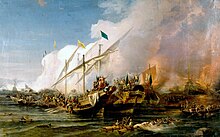
From 1559, the North African cities of Algiers, Tunis, and Tripoli, although nominally part of the Ottoman Empire, were autonomous military republics that chose their rulers and lived by war booty captured from the Spanish and Portuguese. There are several cases of Sephardic Jews, including Sinan Reis and Samuel Pallache, who upon fleeing Iberia attacked the Spanish Empire's shipping under the Ottoman flag.
During the first period (1518–1587), the beylerbeys were admirals of the sultan, commanding great fleets and conducting war operations for political ends. They were slave hunters, and their methods were ferocious. After 1587, the sole object of their successors was plundering, both on land and sea. The maritime operations were conducted by the captains, or reises, who formed a class or even a corporation. Cruisers were fitted out by investors and commanded by the reises. 10% of the value of the prizes was paid to the pasha or his successors, who bore the titles of agha or dey or bey.
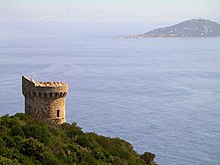
In 1544, Hayreddin captured the island of Ischia, taking 4,000 prisoners, and enslaved some 2,000–7,000 inhabitants of Lipari. In 1551, Turgut Reis enslaved the entire population of the Maltese island of Gozo, between 5,000 and 6,000, sending them to Ottoman Tripolitania. In 1554, corsairs under Turgut Reis sacked Vieste, beheaded 5,000 of its inhabitants, and abducted another 6,000.
17th century

In the early years of the 17th century, the Barbary states attracted English pirates, many of whom had previously operated as privateers under Queen Elizabeth I. Still, they found themselves unwanted by her successor King James VI and I. Whereas in England, these pirates were reviled, in the Barbary states, they were respected and had access to safe markets to resupply and repair their ships. Many of these pirates converted to Islam.
A notable Christian action against the Barbary states occurred in 1607, when the Knights of Saint Stephen (under Jacopo Inghirami) sacked Bona in Algeria, killing 470 and taking 1,464 captives. This victory is commemorated by a series of frescoes painted by Bernardino Poccetti in the "Sala di Bona" of Palazzo Pitti, Florence. In 1611, Spanish galleys from Naples, accompanied by the galleys of the Knights of Malta, raided the Kerkennah Islands off the coast of Tunisia and took away almost 500 Muslim captives. Between 1568 and 1634, the Knights of Saint Stephen may have captured about 14,000 Muslims, with perhaps one-third taken in land raids and two-thirds taken on captured ships.
Ireland was attacked similarly. In June 1631, Murat Reis, with corsairs from Algiers and armed troops of the Ottoman Empire, stormed ashore at the little harbor village of Baltimore, County Cork. They captured almost all the villagers and took them away to a life of slavery in North Africa. The prisoners were destined for a variety of fates—some lived out their days chained to the oars as galley slaves. At the same time, women spent long years as concubines in harems or within the walls of the sultan's palace. Only two of these captives ever returned to Ireland. England was also subject to pirate raids; in 1640, 60 men, women and children were enslaved by Algerian corsairs who raided Penzance.
More than 20,000 captives were said to be imprisoned in Algiers alone. The rich were often able to secure release through ransom, but the poor were condemned to slavery. Their masters would, on occasion, allow them to secure freedom by professing Islam. A long list might be given of people of good social position, not only Italians or Spaniards but German or English travelers in the south, who were captives for a time.
In 1675, a Royal Navy squadron led by Sir John Narborough negotiated a lasting peace with Tunis and, after bombarding the city to induce compliance, with Tripoli.
-
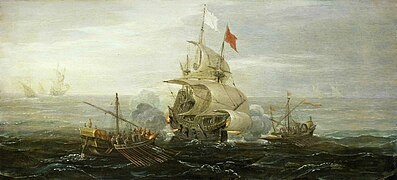 A French Ship and Barbary Pirates by Aert Anthonisz, c. 1615
A French Ship and Barbary Pirates by Aert Anthonisz, c. 1615
-
 Battle of a French ship of the line and two galleys of the Barbary corsairs
Battle of a French ship of the line and two galleys of the Barbary corsairs
-
 An action between an English ship and vessels of the Barbary Corsairs
An action between an English ship and vessels of the Barbary Corsairs
-
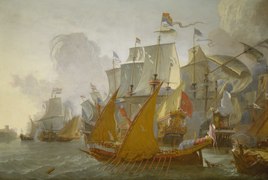 Lieve Pietersz Verschuier, Dutch ships bomb Tripoli in a punitive expedition against the Barbary pirates, c. 1670
Lieve Pietersz Verschuier, Dutch ships bomb Tripoli in a punitive expedition against the Barbary pirates, c. 1670
18th–19th centuries
See also: First Barbary War and Second Barbary War
Piracy was enough of a problem for some states to enter the redemption business. In Denmark:
At the beginning of the 18th century, money was collected systematically in all churches, and a so-called 'slave fund' (slavekasse) was established by the state in 1715. Funds were brought in through a compulsory insurance sum for seafarers. This institution ransomed 165 slaves between 1716 and 1736.
Between 1716 and 1754, 19 ships from Denmark-Norway were captured with 208 men; piracy was thus a serious problem for the Danish merchant fleet.
Until the American Declaration of Independence in 1776, British treaties with the North African states protected American ships from the Barbary corsairs. During the American Revolutionary War, the Corsairs attacked American merchant vessels in the Mediterranean. However, on December 20, 1777, Sultan Mohammed III of Morocco issued a declaration recognizing America as an independent country, and stating that American merchant ships could enjoy safe passage into the Mediterranean and along the coast. The relations were formalized with the Moroccan–American Treaty of Friendship signed in 1786, which stands as the U.S.'s oldest non-broken friendship treaty with a foreign power.
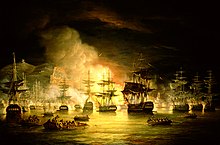
The Barbary threat led directly to the United States founding the United States Navy in March 1794. While the United States did secure peace treaties with the Barbary states, it was obliged to pay tribute for protection from attack. The burden was substantial: from 1795, the annual tribute paid to the Regency of Algiers amounted to 20% of United States federal government's annual expenditures.
In 1798, an islet near Sardinia was attacked by the Tunisians, and more than 900 inhabitants were taken away as slaves.

The Barbary states had difficulty securing uniform compliance with a total prohibition of slave-raiding, as this had been traditionally of central importance to the North African economy. Slavers continued to take captives by preying on less well-protected peoples. Algiers subsequently renewed its slave-raiding, though on a smaller scale. Europeans at the Congress of Aix-la-Chapelle in 1818 discussed possible retaliation. In 1824, a British fleet under Admiral Sir Harry Burrard Neale bombarded Algiers. Corsair activity based in Algiers did not entirely cease until France conquered the state in 1830.
Barbary slave trade
Main article: Barbary slave tradeFrom bases on the Barbary Coast, North Africa, the Barbary corsairs raided ships travelling through the Mediterranean and along the northern and western coasts of Africa, plundering their cargo and enslaving the people they captured. From at least 1500, the corsairs also conducted raids along seaside towns of Italy, France, Spain, Portugal, England and as far away as Iceland, capturing men, women and children. On some occasions, settlements such as Baltimore, Ireland were abandoned following the raid, only being resettled many years later. Between 1609 and 1616, England alone had 466 merchant ships lost to Barbary corsairs.
Slave quarters
At night the slaves were put into prisons called 'bagnios' (derived from the Italian word "bagno" for public bath, inspired by the Turks' use of Roman baths at Constantinople as prisons), which were often hot and overcrowded. Bagnios had chapels, hospitals, shops and bars run by captives.
Galley slaves
See also: Galley slave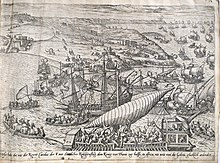
Although the conditions in bagnios were harsh, they were better than those endured by galley slaves. Most Barbary galleys were at sea for around eighty to a hundred days a year, but when the slaves assigned to them were on land, they were forced to do hard manual labor. There were exceptions:
galley slaves of the Ottoman Sultan in Constantinople would be permanently confined to their galleys, and often served extremely long terms, averaging around nineteen years in the late seventeenth-century and early eighteenth-century periods. These slaves rarely got off the galley but lived there for years.
During this time, rowers were shackled and chained where they sat, and never allowed to leave. Sleeping (which was limited), eating, defecation and urination took place at the seat to which they were shackled. There were usually five or six rowers on each oar. Overseers would walk back and forth and whip slaves considered not to be working hard enough.
Number of people enslaved
The number of slaves captured by Barbary corsairs are difficult to quantify. According to Robert Davis, between 1 million and 1.25 million Europeans were captured by Barbary corsairs and sold as slaves in North Africa and Ottoman Empire between the 16th and 19th centuries. However, to extrapolate his numbers, Davis assumes the number of European slaves captured by Barbary corsairs were constant for a 250-year period, stating:
There are no records of how many men, women and children were enslaved, but it is possible to calculate roughly the number of fresh captives that would have been needed to keep populations steady and replace those slaves who died, escaped, were ransomed, or converted to Islam. On this basis it is thought that around 8,500 new slaves were needed annually to replenish numbers—about 850,000 captives over the century from 1580 to 1680. By extension, for the 250 years between 1530 and 1780, the figure could easily have been as high as 1,250,000.

Historians welcomed Davis's attempt to quantify the number of European slaves, but were divided as to the accuracy of the unorthodox methodology which he relied on in the absence of written records. The historian David Earle, author of The Corsairs of Malta and Barbary and The Pirate Wars, questioned Davis, saying "His figures sound a bit dodgy and I think he may be exaggerating." He cautioned that the true picture of European slaves is clouded by the fact that the corsairs also seized non-Christian whites from eastern Europe and black people from west Africa. He wouldn't "hazard a guess about their total". Professor Ian Blanchard, an expert on African trade and economic history at the University of Edinburgh, said that Davis's work was solid and that a number over a million was in line with his expectations.
Davis notes that his calculations were based on observers reports of approximately 35,000 European Christian slaves on the Barbary Coast at any one time during the late 1500s and early 1600s, held in Tripoli, Tunis and, mostly, Algiers.
Legacy
The history of Muslim enslavement of white Europeans has been cited by some as contextualising the importance of subsequent European and American enslavement of blacks. Scholar Robert Davis noted that the larger picture isn't so one-sided: during a "clash of empires... taking slaves was part of the conflict," and at the same time 2 million Europeans were enslaved by Muslims in North Africa and the Near East, 1 million Muslim slaves in Europe.
As Dr. John Callow at University of Suffolk notes, the experience of enslavement by the Barbary corsairs preceded the Atlantic slave trade and "the memory of slavery, and the methodology of slaving, that was burned into the British consciousness was first and foremost rooted in a North African context, where Britons were more likely to be slaves than slave masters."

Barbary corsairs
According to historian, Adrian Tinniswood, the most notorious corsairs were European renegades who had learned their trade as privateers, and who moved to the Barbary Coast during peacetime to pursue their trade. These outcasts, who had converted to Islam, brought up-to-date naval expertise to the piracy business, and enabled the corsairs to make long-distance slave-catching raids as far away as Iceland and Newfoundland. Infamous corsair Henry Mainwaring, who was initially a lawyer and pirate-hunter, later returned home to a royal pardon. Mainwaring later wrote a book about the practise of piracy in the Mediterranean, aptly titled the Discourse of Pirates. In the book, Mainwaring outlined potential methods to hunt down and eliminate piracy.
Barbarossa brothers
Oruç Barbarossa
Main article: Oruç ReisThe most famous of the corsairs in North Africa were the Barbarossa brothers, Aruj and Khayr al-Din. They, and two less well-known brothers all became Barbary corsairs in the service of the Ottoman Empire who later became "Kings" when they established a new state in the Maghreb known as the Ottoman Regency of Algiers. They were called the Barbarossas (Italian for Redbeards) after the red beard of Oruç, the eldest. Oruç captured the island of Djerba for the Hafsids in 1502 or 1503. He often attacked Spanish coasts and their territories on the coast of North Africa; during one failed attempt in Béjaia in 1512 he lost his left arm to a cannonball. The eldest Barbarossa also went to capture Algiers in 1516. Well aided by his Berber allies from the Kingdom of Kuku, he vanquished a Spanish expedition intended to replace the Spanish vassal ruler of Algiers that he executed with his son along with everybody he suspected would oppose him in favor of his Spanish foes, including local Zayyanid rulers. He was finally captured and killed by the Spanish in Tlemcen in 1518, and put on display.
Hızır Hayreddin Barbarossa
Main article: Hayreddin Barbarossa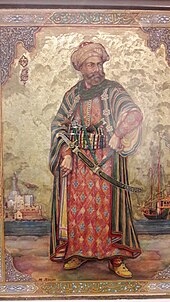
Oruç, based mainly on land, was not the best-known of the Barbarossas. His youngest brother Hızır (later called Hayreddin or Kheir ed-Din) was a more traditional corsair. After capturing many crucial coastal areas, Hayreddin was appointed admiral-in-chief of the Ottoman sultan's fleet. Under his command the Ottoman Empire was able to gain and keep control of the Mediterranean for over thirty years. Barbaros Hızır Hayreddin Pasha died in 1546 of a fever, possibly the plague.
Captain Jack Ward
Main article: Jack WardEnglish corsair Jack, or John, Ward was once called "beyond doubt the greatest scoundrel that ever sailed from England" by the English ambassador to Venice. Ward was a privateer for Queen Elizabeth during her war with Spain; after the end of the war, he became a corsair. With some associates he captured a ship in about 1603 and sailed it to Tunis; he and his crew converted to Islam. He was successful and became rich. He introduced heavily armed square-rigged ships, used instead of galleys, to the North African area, a major reason for the Barbary's future dominance of the Mediterranean. He died of plague in 1622.
Sayyida al-Hurra
Main article: Sayyida al HurraSayyida al-Hurra was a female Muslim cleric, merchant, governor of Tétouan, and later the wife of the sultan of Morocco. She was born around 1485 in the Emirate of Granada, but was forced to flee to Morocco when she was very young to escape the Reconquista. In Morocco, she gathered a crew largely of exiled Moors, and launched pirate expeditions against Spain and Portugal to avenge the Reconquista, protect Morocco from Christian pirates, and seek riches and glory. Sayyida al-Hurra became wealthy and renowned enough for the Sultan of Morocco, Ahmad al-Wattasi to make her his queen. Notably, however, she refused to marry in his capital of Fez, and would not get married but in Tétouan, of which she was governor. This was the first and only time in history that a Moroccan monarch married away from their capital.
Raïs Hamidou
Main article: Raïs HamidouHamidou ben Ali, known as Raïs Hamidou (Arabic: الرايس حميدو), or Amidon in American literature, born around 1770, and died on June 17, 1815, near Cape Gata off the coast of southern Spain, was an Algerian corsair. He captured up to 200 ships during his career. Hamidou ensured the prosperity of the Deylik of Algiers, and gave it its last glory before the French invasion. His biography is relatively well known because the French archivist Albert Devoulx has found important documents, including a precious register of prizes opened by the authorities of the Deylik in 1765. Songs and legends have also taken hold of this charismatic character.
Other Famous Barbary corsairs
- Kemal Reis (c. 1451–1511)
- Mohamed Ben Hassan (c. 1688 – 1724)
- Muhammad I Pasha (c. 1688–1784)
- Hasan Pasha (c. 1517–1572)
- Gedik Ahmed Pasha (died 1482)
- Sinan Reis (died 1546)
- Piri Reis (died 1554 or 1555)
- Turgut Reis (1485–1565)
- Sinan Pasha (died 1553)
- Kurtoğlu Muslihiddin Reis (1487–c. 1535)
- Kurtoğlu Hızır Reis
- Salih Reis (c. 1488–1568)
- Seydi Ali Reis (1498–1563)
- Piyale Pasha (c. 1515–1578)
- Raïs Hamidou (1773–1815)
- Uluç Ali Reis (1519–1587)
- Ali Bitchin (c. 1560–1645)
- Simon de Danser or Simon Reis (c. 1579–c. 1611)
- Ivan-Dirkie de Veenboer or Sulayman Reis (died 1620)
- Murat Reis the Elder (c. 1534–1638)
- Jan Janszoon or Murat Reis the Younger (c. 1570–after 1641)
In fiction

Barbary corsairs are protagonists in Le pantere di Algeri (the panthers of Algiers) by Emilio Salgari. They were featured in a number of other noted novels, including Robinson Crusoe by Daniel Defoe, The Count of Monte Cristo by Alexandre Dumas, père, The Wind in the Willows by Kenneth Grahame, The Sea Hawk and the Sword of Islam by Rafael Sabatini, The Algerine Captive by Royall Tyler, Master and Commander by Patrick O'Brian, the Baroque Cycle by Neal Stephenson, The Walking Drum by Louis Lamour, Doctor Dolittle by Hugh Lofting, Corsair by Clive Cussler, Tanar of Pellucidar by Edgar Rice Burroughs, and Angélique in Barbary by Anne Golon.
Miguel de Cervantes, the Spanish author, was captive for five years as a slave in the bagnio of Algiers, and reflected his experience in some of his fictional (but not directly autobiographical) writings, including the Captive's tale in Don Quixote, his two plays set in Algiers, El Trato de Argel (The Treaty of Algiers) and Los Baños de Argel (The Baths of Algiers), and episodes in a number of other works.
In Mozart's opera Die Entführung aus dem Serail (a Singspiel), two European ladies are discovered in a Turkish harem, presumably captured by Barbary corsairs. Rossini's opera L'italiana in Algeri is based on the capture of several slaves by Barbary corsairs led by the bey of Algiers.
See also
- Albanian piracy
- Anglo-Turkish piracy
- Barbary slave trade
- Barbary treaties
- Circassian beauty
- Corsairs of Algiers
- Ghazi (warrior)
- History of slavery in the Muslim world
- Islamic views on slavery
- List of Ottoman conquests, sieges and landings
- Mathurin Romegas
- Morisco
- Morocco–United States relations
- Ottoman–Habsburg wars
- Ottoman Imperial Harem
- Ottoman Navy
- Piracy in Scotland
- Regency of Algiers
- Republic of Salé
- Slavery in the Ottoman Empire
- Turkish Abductions
Notes
- Geoffrey F. Gresh, Tugrul Keskin (2018). US Foreign Policy in the Middle East From American Missionaries to the Islamic State. Routledge. p. 1985. ISBN 978-1-351-16962-2.
- سرهنك, المير ألاي إسماعيل (1988). تاريخ الدولة العثمانية (in Arabic). دار الفكر الحديث للطبع والنشر.
- Murray, Hugh (1841). The Encyclopædia of Geography: Comprising a Complete Description of the Earth, Physical, Statistical, Civil, and Political. Lea and Blanchard.
- ^ Robert Davis (2011-02-17). "British Slaves on the Barbary Coast". BBC. Retrieved 27 March 2019.
- ^ Review of Pirates of Barbary by Ian W. Toll, The New York Times, 12 Dec. 2010
- ^ Carroll, Rory (2004-03-11). "New book reopens old arguments about slave raids on Europe". The Guardian. ISSN 0261-3077. Retrieved 2017-12-11.
- Conlin, Joseph R. The American Past: A Survey of American History, Volume I: To 1877. p. 206.
- Chaney, Eric (2015-10-01). "Measuring the military decline of the Western Islamic World: Evidence from Barbary ransoms". Explorations in Economic History. 58: 107–124. doi:10.1016/j.eeh.2015.03.002.
- Weller, Thomas (2024-09-11). "The Spanish Century". Europäische Geschichte Online (EGO) / European History Online. Archived from the original on 2024-05-27.
- Fareed, Muhammad. تاريخ الدولة العلية العثمانية. Retrieved 28 July 2024.
- Pryor (1988), p. 192
- Kritzler, Edward (November 3, 2009). Jewish Pirates of the Caribbean. Anchor. pp. 59–60. ISBN 978-0-7679-1952-4. Retrieved 2010-05-02.
- Plaut, Steven (October 15, 2008). "Putting the Oy Back into 'Ahoy'". Retrieved 2010-04-27. Archived 2013-11-10 at the Wayback Machine
- ^ Chisholm, Hugh, ed. (1911). "Barbary Pirates" . Encyclopædia Britannica (11th ed.). Cambridge University Press.
- Syed, Muzaffar Husain; Akhtar, Syed Saud; Usmani, B. D. (2011-09-14). Concise History of Islam. Vij Books India Pvt Ltd. ISBN 9789382573470.
- Her Majesty's Commission, State Papers (1849). King Henry the Eighth Volume 10 Part V Foreign Correspondence 1544-45. London.
- Mercati, Angelo (1982). Saggi di storia e letteratura, vol. II. Rome.
{{cite book}}: CS1 maint: location missing publisher (link) - Fuchs, Barbara (2000). "Faithless Empires: Pirates, Renegadoes, and the English Nation". ELH. 67 (1): 45–69. doi:10.1353/elh.2000.0002. JSTOR 30031906.
- John B. Hattendorf and Richard W. Unger (2003). War at Sea in the Middle Ages and the Renaissance. Boydell Press.
{{cite book}}: CS1 maint: location missing publisher (link) - "Curator's comments on a draft study by Bernardino Poccetti". The British Museum.
- "Palazzo Pitti".
- ^ Jamieson, Alan (2012). Lords of the Sea: A History of the Barbary Corsairs. London.
{{cite book}}: CS1 maint: location missing publisher (link) - Ekin, Des (2006). The Stolen Village – Baltimore and the Barbary Pirates. OBrien. ISBN 978-0-86278-955-8.
- British Captives from the Mediterranean to the Atlantic, 1563-1760. Nabil Matar.
- Pirates of Barbary. Adrian Tinniswood. Random House.
- Articles of peace & commerce between ... Charles II ... and the ... Lords the Bashaw, Dey, Aga, Divan, and governours of the ... kingdom of Tripoli concluded by Sir John Narbrough ... the first day of May, 1676. University of Michigan. 6 August 1677.
- ^ Peter Madsen, "Danish slaves in Barbary", Islam in European Literature Conference, Denmark Archived November 10, 2014, at the Wayback Machine
- Tucker, Spencer C. (2014-06-11). The Encyclopedia of the Wars of the Early American Republic, 1783–1812: A Political, Social, and Military History [3 volumes]: A Political, Social, and Military History. Abc-Clio. ISBN 9781598841572.
- Roberts, Priscilla H. and Richard S. Roberts, Thomas Barclay (1728–1793): Consul in France, Diplomat in Barbary, Lehigh University Press, 2008, pp. 206–223.
- "Milestones of American Diplomacy, Interesting Historical Notes, and Department of State History". U.S. Department of State. Retrieved 2007-12-17.
- David Brion Davis, Steven Mintz (2000). The Boisterous Sea of Liberty A Documentary History of America from Discovery through the Civil War. Oxford University Press. p. 222. ISBN 978-0-19-511669-4.
- Christian Slaves, Muslim Masters: White Slavery in the Mediterranean, the Barbary Coast and Italy, 1500–1800. Robert Davis (2004). p.45. ISBN 1-4039-4551-9.
- Rees Davies, "British Slaves on the Barbary Coast", BBC, 1 July 2003
- Definition of "bagnio" from the Free Merriam-Webster Dictionary. Accessed 23 February 2015
- H. G. Barnby (1966). The Prisoners of Algiers: An Account of the Forgotten American-Algerian War 1785-1797. Oxford U.P. pp. 45–52.
- Ekin, Des (2006). The Stolen Village – Baltimore and the Barbary Pirates. OBrien. p. 187. ISBN 978-0-86278-955-8.
- Davis, Robert. Christian Slaves, Muslim Masters: White Slavery in the Mediterranean, the Barbary Coast and Italy, 1500–1800.
- "When Europeans were slaves: Research suggests white slavery was much more common than previously believed" Archived 2011-07-25 at the Wayback Machine, Research News, Ohio State University
- Davis, Robert (17 February 2011). "British Slaves on the Barbary Coast". BBC.
- Grabmeier, Jeff (2020-03-21). "Why is a 16-year-old book on slavery so popular now?". Ohio State University News. Retrieved 2022-10-24.
- Callow, John (2017-01-02). "British captives and slaves in North Africa". The Seventeenth Century. 32 (1): 103–107. doi:10.1080/0268117X.2016.1250227. ISSN 0268-117X. S2CID 164633295.
- Crawford, Michael H. (2012-11-08). Causes and Consequences of Human Migration: An Evolutionary Perspective. Cambridge University Press. p. 180. ISBN 978-1-107-01286-8.
- Mernissi, Fatima (July 30, 1997). The Forgotten Queens of Islam. Univ of Minnesota Press. pp. 18–19, 115, 193. ISBN 978-0-8166-2439-3.
- Park, Thomas Kerlin; Boum, Aomar (2006). Historical dictionary of Morocco. The Scarecrow Press, Inc. p. 317. ISBN 978-0-8108-5341-6.
- de Courcy, J. (1974). "RAÏS HAMIDOU: THE LAST OF THE GREAT ALGERIAN CORSAIRS". The Mariner's Mirror. 60 (2). Informa UK Limited: 187–196. doi:10.1080/00253359.1974.10657964. ISSN 0025-3359.
- BEAUCARNOT, Jean-Louis; DUMOULIN, Frédéric (2015-06-11). Dictionnaire étonnant des célébrités (in French). edi8. ISBN 978-2-7540-7767-5.
- Devoulx 1859.
References
- Clissold, Stephen. 1976. "Christian Renegades and Barbary Corsairs." History Today 26, no. 8: 508–515. Historical Abstracts.
- Davis, Robert C., Christian Slaves, Muslim Masters: White Slavery in the Mediterranean, The Barbary Coast, and Italy, 1500–1800. Palgrave Macmillan, New York. 2003. ISBN 0-333-71966-2
- Devoulx, Albert (1859). Le raïs Hamidou: notice biographique sur le plus célèbre corsaire algérien du XIIIe siècle de l'hégire (PDF). Dubos Frères.
- Earle, Peter. The Pirate Wars. Thomas Dunne. 2003.
- Forester, C. S. The Barbary Pirates. Random House. 1953.
- Heers, Jacques. The Barbary Corsairs: Warfare in the Mediterranean, 1480–1580. Greenhill Books. 2003.
- Konstam, Angus. A History of Pirates. Lyons Press. 1999.
- Kristensen, Jens Riise. Barbary To and Fro Ørby Publishing. 2005.
- Leiner, Frederick C. The End of Barbary Terror: America's 1815 War against the Pirates of North Africa. Oxford University Press, Oxford. 2006.
- Lambert, Frank. The Barbary Wars: American Independence in the Atlantic World. Hill & Wang, 2005.
- Lloyd, Christopher. 1979. "Captain John Ward: Pirate." History Today 29, no. 11; p. 751.
- Matar, Nabil. 2001. "The Barbary Corsairs, King Charles I and the Civil War." Seventeenth Century 16, no. 2; pp. 239–258.
- Pryor, John H., Geography, Technology, and WarStudies in the Maritime History of the Mediterranean, 649–1571. Cambridge University Press, Cambridge. 1988. ISBN 0-521-34424-7
- Severn, Derek. "The Bombardment of Algiers, 1816." History Today 28, no. 1 (1978); pp. 31–39.
- Silverstein, Paul A. 2005. "The New Barbarians: Piracy and Terrorism on the North African Frontier." CR: The New Centennial Review 5, no. 1; pp. 179–212.
- Travers, Tim, Pirates: A History. Tempus Publishing, Gloucestershire. 2007.
- World Navies
- To the Shores of Tripoli: The Birth of the U.S. Navy and Marines. Annapolis, MD : Naval Institute Press, 2001
Further reading
- Clark, G. N. "The Barbary Corsairs in the Seventeenth Century." Cambridge Historical Journal 8#1 (1944): 22–35. online.
- Gawalt, Gerard W. "America and the Barbary pirates: An international battle against an unconventional foe." (Library of Congress, 2011) online.
- London, Joshua E. Victory in Tripoli: How America's War with the Barbary Pirates Established the U.S. Navy and Shaped a Nation. New Jersey: John Wiley & Sons, Inc., 2005. ISBN 978-0-471-44415-2
- Sofka, James R. "The Jeffersonian idea of national security: commerce, the Atlantic balance of power, and the Barbary war, 1786–1805." Diplomatic History 21.4 (1997): 519–544. online
- Turner, Robert F. "President Thomas Jefferson and the Barbary Pirates." in Bruce A Elleman, et al. eds. Piracy and Maritime Crime: Historical and Modern Case Studies (2010): 157–172. online
- Adrian Tinniswood, Pirates of Barbary: Corsairs, Conquests and Captivity in the Seventeenth-Century Mediterranean, 343 pp. Riverhead Books, 2010. ISBN 978-1-59448-774-3. NY Times review
- White, Joshua M.Piracy and Law in the Ottoman Mediterranean (Stanford University Press, 2017). ISBN 978-1-50360-252-6.
- White Gold: The Extraordinary Story of Thomas Pellow and North Africa's One Million European Slaves by Giles Milton (Sceptre, 2005)
- Zacks, Richard. The pirate coast : Thomas Jefferson, the first marines and the secret mission of 1805 Hyperion, 2005. ISBN 1-4013-0849-X
- Christian slaves, Muslim masters : white slavery in the Mediterranean, the Barbary Coast, and Italy, 1500–1800 by Robert C. Davis. New York : Palgrave Macmillan, 2003. ISBN 978-0-333-71966-4
- Piracy, Slavery and Redemption: Barbary Captivity Narratives from Early Modern England by D. J. Vikus (Columbia University Press, 2001)
- The Stolen Village: Baltimore and the Barbary Pirates by Des Ekin ISBN 978-0-86278-955-8
- Skeletons on the Zahara: A True Story of Survival by Dean King, ISBN 0-316-15935-2
- Oren, Michael. "Early American Encounters in the Middle East", in Power, Faith, and Fantasy. New York: Norton, 2007.
- Boot, Max (2002). The Savage Wars of Peace: Small Wars and the Rise of American Power. New York: Basic Books. ISBN 978-0-465-00720-2.
- Lambert, Frank. The Barbary Wars. New York: Hill and Wang, 2005.
- Whipple, A. B. C. To the Shores of Tripoli: The Birth of the U.S. Navy and Marines. Bluejacket Books, 1991. ISBN 1-55750-966-2
External links
- Knights Hospitaller of St. John – Order of St John of Jerusalem Malta
- The Barbary Pirates
- New book reopens old arguments about slave raids on Europe
- Barbary Warfare
- The Barbary Wars at the Clements Library:An online exhibit on the Barbary Wars with images and transcriptions of primary documents from the period.
- American Barbary Wars
| Piracy | |||||||||
|---|---|---|---|---|---|---|---|---|---|
| Periods | |||||||||
| Types of pirate |
| ||||||||
| Areas |
| ||||||||
| Major figures |
| ||||||||
| Pirate ships | |||||||||
| Pirate battles and incidents | 
| ||||||||
| Piracy law |
| ||||||||
| Slave trade | |||||||||
| Pirates in popular culture |
| ||||||||
| Miscellaneous | |||||||||
| Meta |
| ||||||||